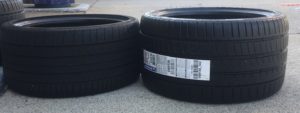Volkswagen Jetta TPMS Description
The 2020 Volkswagen Jetta comes with a tire pressure monitoring system (TPMS) that will notify the driver if one or more tires are below their optimal level. This innovative feature helps ensure you stay safe and in control while on the road. The Volkswagen Jetta’s Anti-lock Brake System (ABS) sensors leverage the car’s motion to indirectly measure and monitor its tires’ pressure levels.
How Does the Volkswagen Jetta TPMS Work?
The ABS (anti-lock brake system) wheel speed sensors send signals to the cars ECU (computer).
The ECU determines the speed each wheel is moving at.
Under-inflated tires creates speed deviations
The ABS system compensates for the speed change, and alerts the driver.
Vehicle indicates low tire pressure warning.
VW Jetta’s Indirect TPMS provides early detection of low tire pressure before the situation escalates into something more dangerous.
 Volkswagen Jetta’s anti-lock brake system sensors (ABS) are not directly designed to monitor the tire pressure in a modern vehicle, but they are used as an indirect way to detect low tire pressure. The wheel speed sensors regularly transmit information to the car’s computer, which then calculates the speed of each wheel. The ABS system uses these speed measurements to detect when a wheel is at risk to lock up during braking. When a tire is under-inflated, it causes the wheel to rotate at a different speed than anticipated. (The ABS wheel speed sensors audits the tread’s rolling circumference of each tire) This deviation in the wheel speed will affect the ABS system’s “expected” behavior and trigger a warning to the driver indicating that the tire pressure may be low. By using the wheel speed signals from the ABS sensors, the vehicle can detect changes in tire pressure without the need for additional sensors, this is known as indirect Tire pressure monitoring system (TPMS).
Volkswagen Jetta’s anti-lock brake system sensors (ABS) are not directly designed to monitor the tire pressure in a modern vehicle, but they are used as an indirect way to detect low tire pressure. The wheel speed sensors regularly transmit information to the car’s computer, which then calculates the speed of each wheel. The ABS system uses these speed measurements to detect when a wheel is at risk to lock up during braking. When a tire is under-inflated, it causes the wheel to rotate at a different speed than anticipated. (The ABS wheel speed sensors audits the tread’s rolling circumference of each tire) This deviation in the wheel speed will affect the ABS system’s “expected” behavior and trigger a warning to the driver indicating that the tire pressure may be low. By using the wheel speed signals from the ABS sensors, the vehicle can detect changes in tire pressure without the need for additional sensors, this is known as indirect Tire pressure monitoring system (TPMS).
Volkswagen Jetta Tire Pressure Warning Light Reset Procedure
Prior to resetting your tire pressure monitoring system, be sure to adjust all tires to the correct values.
Turn the vehicle ignition to the ON position
Select VEHICLE
Select SETTINGS
Select TIRES
Select SET in Tire Settings
when prompted “Do all four tire pressure readings comply with the required values” select CONFIRM
Afterwards you will see a message that says “Tire pressures have been stored”
After resetting the TPMS system, it’s important to drive your Jetta for a while to allow the system to relearn the tire pressures. If the light turns on again after driving, it’s possible that one or more of your tires is still under-inflated. Repeat the process until the light stays off.
What Happens to Under-Inflated Tires?
 Tires that are under-inflated can cause a number of problems for your vehicle. First and foremost, under-inflated tires can negatively impact the handling and performance of your vehicle. When a tire is under-inflated, the sidewall of the tire flexes more, which generates more heat and causes the tire to wear out more quickly. Additionally, under-inflated tires can negatively impact your vehicle’s fuel efficiency, as they require more energy to roll.
Tires that are under-inflated can cause a number of problems for your vehicle. First and foremost, under-inflated tires can negatively impact the handling and performance of your vehicle. When a tire is under-inflated, the sidewall of the tire flexes more, which generates more heat and causes the tire to wear out more quickly. Additionally, under-inflated tires can negatively impact your vehicle’s fuel efficiency, as they require more energy to roll.
Under-inflated tires also present a significant safety hazard. When a tire is under-inflated, the amount of rubber in contact with the road is reduced, which can cause the tire to overheat and potentially fail. Under-inflated tires are also more prone to hydroplaning on wet roads, which can cause a loss of control. Furthermore, under-inflated tires can also cause uneven wear, which can lead to uneven tire wear or even a blowout.
What Causes a Tire's Circumference to Change? (TPMS Light)
When a tire’s sidewall is damaged.
When the tire tread is damaged.
When a tire is leaking air or has too much air.
If snow chains are installed on tires.
If the load of the vehicle is uneven. (one side heavier then the other)
If a tire or wheel/rim is changed with a different size tire or wheel.
Tire Maintenance
Basic tire maintenance is an important aspect of keeping your vehicle in good working condition and ensuring a safe ride. Proper tire maintenance includes regular checks of tire pressure, alignment, balance, and tread depth.
First, it is important to check tire pressure regularly, as under-inflated or over-inflated tires can negatively impact the performance and safety of your vehicle. It is recommended to check tire pressure at least once a month when tires are cold. The recommended tire pressure for your vehicle can be found in the vehicle’s manual or on the sticker located on the driver’s side door jamb.
Alignment refers to the positioning of the tires in relation to each other and the road. Misaligned tires can cause uneven wear and can negatively impact the handling of your vehicle. It is recommended to have your tires aligned at least once a year or whenever you notice uneven wear on your tires.
Balance refers to the distribution of weight around the tire. Unbalanced tires can cause vibrations while driving and can lead to uneven wear. It is recommended to have your tires balanced every time new tires are installed or when you notice vibrations or steering pull while driving.
Lastly, it is important to check the tread depth of your tires. Tires with worn-out tread can negatively impact the performance and safety of your vehicle, especially in wet conditions. It is recommended to check tread depth regularly and replace tires when the tread depth is below 4/32 of an inch.
In conclusion, regular tire maintenance is essential to ensure the safety and performance of your vehicle. By following these basic guidelines, you can extend the life of your tires and ensure a smooth and safe ride.


